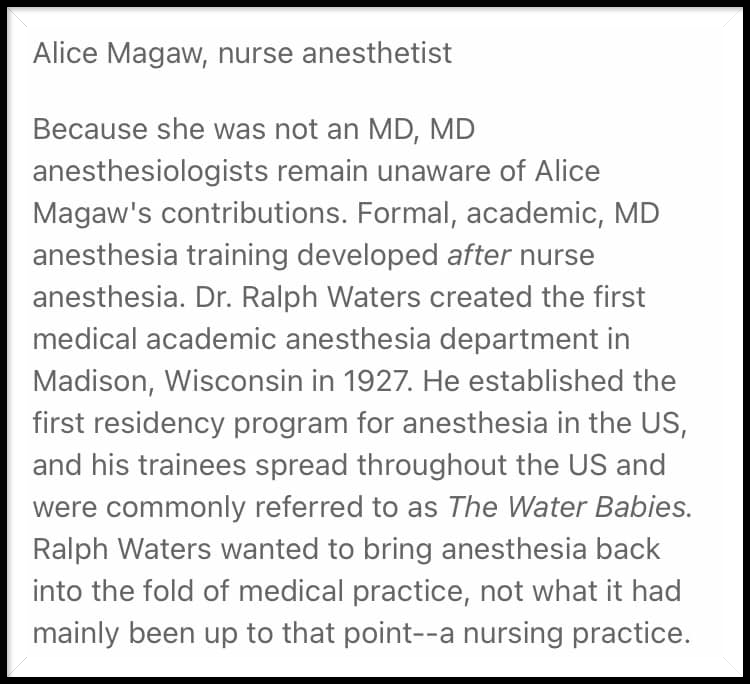HISTORY OF CRNAs
Alice Magaw Kessel (1860-1928)
Nurse Anesthetist Pioneer
Performed 14,380 procedures with NO fatalities
Nurse anesthetists have been providing anesthesia care to patients in the United States for more than 150 years. The Certified Registered Nurse Anesthetist (CRNA) credential came into existence in 1956 and, in 1986, CRNAs became the first nursing specialty accorded direct reimbursement rights from Medicare. In 2001, the Centers for Medicare & Medicaid Services (CMS) changed the federal physician supervision rule for nurse anesthesiologists to allow state governors to opt-out of this requirement so that facilities could get reimbursed for the services provided by a CRNA.
“𝘍𝘰𝘳𝘮𝘢𝘭, 𝘢𝘤𝘢𝘥𝘦𝘮𝘪𝘤, 𝘔𝘋 𝘢𝘯𝘦𝘴𝘵𝘩𝘦𝘴𝘪𝘢 𝘵𝘳𝘢𝘪𝘯𝘪𝘯𝘨 𝘥𝘦𝘷𝘦𝘭𝘰𝘱𝘦𝘥 𝙖𝙛𝙩𝙚𝙧 𝘯𝘶𝘳𝘴𝘦 𝘢𝘯𝘦𝘴𝘵𝘩𝘦𝘴𝘪𝘢.”
— Matthew Mazurek, MD

Video published May 5, 2012. Since then there have been some updates. As of August 2022:
- Currently there are ~60,000 CRNAs and Residents in training in USA.
- As of 2020 the AANA changed its official name to the American Association of Nurse Anesthesiology.
- As of 2022 all CRNAs are now doctorally prepared prior to sitting for their board certification exam to practice anesthesiology.
*Click the links for further explanation
1877 - Sister Mary Bernard, at Saint Vincents hospital in Erie, Pennsylvania, became first nurse to specialize in anesthesia.
1893 - Alice Magaw began working as a nurse anesthetist at Saint Mary's Hospital in Rochester, Minnesota, for Dr. Charles Mayo. He later bestows upon her the title "mother of Anesthesia” for her mastery of open drop ether.
1915 - Agatha Hodgkins formally established the Lakeside Hospital School of Anesthesia in Cleveland, Ohio. She had been teaching nurse anesthesia nurses and doctors there since 1911.
1931 - Agatha Hodgkins founded The National Association of Nurse Anesthetists (NANA) on June 17 in Cleveland, Ohio; the first national Association of anesthesia providers in US.
1933 - First Annual Meeting takes place in Milwaukee with 120 attendees; Agatha Hodgkin's elected honorary president.
1934 - In commerce – Francis v. Nelson, the California Supreme Court affirmed the finding for nurse anesthetist Dagmar Nelson in a ruling that confirmed the legality of the Nurse Anesthesia Department. AANA files its first amicus brief for the case.
1939 - NANA changed its name to the American Association of Nurse Anesthetists (AANA) and re-incorporated in Illinois on October 17.
1941 – The AANA seal "The watchful care of the sleeper by the light of the lamp of learning" was adopted.
1944 – AANA membership was extended to African-American nurse anesthetists.
1945 – AANA administers the first nurse anesthetist qualifying (certification) exam to 290 women in 39 hospitals in 28 states, plus one in territory of Hawaii.
1947 – The first issue of the News Bulletin is published. AANA membership was extended to male nurse anesthetists.
1951 – Reverend Francis Przybylski wrote the prayer to Saint René, the new leader - designated patron saint of anesthetist.
1955 -The U.S.department of health, education, and welfare recognized the AANA as the accrediting agency for Schools of Nursing Anesthesiology.
1956 - Certified Registered Nurse Anesthetist (CRNA) credential is adopted.
1961 – The film strip "Anesthesia: a special type of nursing" was released and won the Blue Ribbon Award at the American Film Festival.
1962 – The Puerto Rico Association of Nurse Anesthetists became the 52nd state affiliate.
1963 - Colonel Mildred Irene Clark, CRNA, became the first nurse anesthetist to serve as Chief of the Army Nurse Corp.
1972 – John Garde, MS, CRNA, FAAN becomes the first male president of the AANA.
1973 – Goldie Brangman, CRNA, becomes the first black president of the AANA.
1974 – A new logo, consisting of the stylized caduceus and the association's initials was introduced.
1975 - The Agatha Hodgkins award for outstanding accomplishment was first presented to Ruth Satterfield, CRNA.
1977 – AANA members approved mandatory continuing education for CRNAs.
1981 - The AANA education and research foundation, today known as the AANA Foundation was created.
1986 – Congress passed legislation providing CRNAs direct reimbursement under Medicare part B, making Nurse Anesthesia the first nursing specialty/non-physician group to be accorded direct reimbursement rates under Medicare.
1990 - AANA Federal Government Affairs office opened in Washington, DC.
1992 - The AANA purchased the new headquarters building 222 S. Prospect Ave. in Park Ridge, Illinois.
1994 - The AANA archives collections were made available to approved researchers.
1996 - The first AANA website was launched.
2000 - The first official Nurse Anesthetist Week was held in January.
2001 - Iowa becomes the first state to Opt-Out (Link to opt-out fact sheet and current Opt-Out states) of the Federal physician supervision required for nursing anesthesiologists.
2004 – The AANA wellness initiative was launched in honor of AANA past president Jen Stewart, who died of an accidental self administered overdose in 2002. The Jan Stewart lecture series features speakers on wellness topics at each AANA Nurse Anesthesiology Annual Conference.
2008 - National Council of State Boards of Nursing adopted the Consensus Model for APRN Regulation: Licensure, Accreditation, Certification & Education - in collaboration with all other advanced practice nursing organizations.
2010 - Health Affairs published “No harm found when nurse anesthetists work without supervision by a physician" by Brian Dulisse and Jerry Cromwell. The study confirm the quality and safety of nurse anesthesiologist care, and the authors recommended that Medicare repeal position supervision requirements for CRNAs.
2010 - Nursing Economics published research conducted by the Lewin Corporation, "Cost Effectiveness Analysis of Anesthesia Providers"
2015 - First rally on Capitol Hill took place during the AANA Mid-Year Assembly in Washington, DC.
2016 - AANA membership reached the 50,000 member milestone.
2016 - The term Nurse Anesthesiologist is adopted by the AANA Board of Directors following a greater than 2/3 majority membership vote during the 2016 AANA Annual Congress.
2020 - Nurse Anesthetists step forward with courage and creativity during the Covid-19 pandemic, and federal and state authorities recognize CRNA's expertise in temporarily removing barriers to care.
2020 - Members vote to change the name from the American Association of Nurse Anesthetists to the American Association of Nurse Anesthesiology.
2021 - Arkansas enacted legislation removing physician supervision, making it the 42nd state with no supervision in the nurse practice act.
2021 - Number of CRNAs and RRNAs/SRNAs exceeds 59,000 in the United States. CRNAs are the largest group of anesthesia providers in the United States.
2022 - Michigan Opts-Out of physician supervision
2022 - Arkansas Opts-Out of physician supervision
2022 - Number of Opt-Out States - 22 plus Guam. Click here for map.

